The Apple iPad Pro Review
by Ryan Smith, Joshua Ho & Brandon Chester on January 22, 2016 8:10 AM ESTDisplay
With the iPad Pro, one of the main points of interest is its display. Although there are other elements to the iPad Pro like the stylus and the keyboard, the display is really the centerpiece of this tablet, especially when neither the Apple Pencil nor the Smart Keyboard come included with the iPad Pro itself. I think it goes without saying that everyone wants to have a great display on a tablet, but what determines a great display is often in question.
While it’s obvious that less reflectance is better, as is higher contrast and maximum brightness, things like gamma and color reproduction are often subjective as the same color will often look different to different people. In order to try and deal with this issue, we focus on testing all mobile displays to the same color accuracy standards. For now, the industry standard gamut is the sRGB gamut, along with power 2.2 gamma. Although the sRGB gamut is relatively limited compared to something like DCI-P3 or Rec. 2020, it remains an industry standard when compared to what exists on the market today. In order to test how well a display meets these standards in addition to other criteria, we use an i1Pro2 spectrophotometer for accurate color measurements along with an i1Display Pro for accurate contrast measurements. In order to organize this data into a readable format we use SpectraCal’s CalMAN 5 with a custom workflow.
In the case of the iPad Pro, it’s obvious that the architecture of the display is different from what we’ve seen in mobile devices before. Due to the sheer resolution, it seems that Apple is electing to use embedded Display Port (eDP) instead of the more traditional MIPI DSI interface used in smartphones. We’ve seen a number of smartphones and tablets this year ship with an 8 lane MIPI DSI configuration which allows for a theoretical maximum of 2715x1697 for about 4.6MP, but the 2732x2048 resolution of the iPad Pro means about 20% more pixels than what a 2 port MIPI DSI configuration can handle.

Source: design-reuse.com
By comparison, eDP has been able to support 4K at 60 Hz or higher for quite some time. This is self-evident by looking at the number of laptops launched with a 4K display. With the iPad Pro, Apple claims that they’ve implemented their own custom timing controller or TCON. Some digging through the system files seems to corroborate these claims as there are numerous references to an Apple Agile DP Display SAC Controller. That’s a mouthful, but Agile seems to be the internal name for this controller, and DP seems to be a reference to DisplayPort, while SAC is likely a reference to Slow Adaptive Clocking.
Slow Adaptive Clocking is something that there's very limited public information on at this time. My best guess here is that this is actually related to the variable refresh rate technology that Apple is implementing in their custom TCON. On the surface this technology seems to bear a lot of resemblance to G-Sync or FreeSync, but rather than varying refresh rate to fit the GPU’s rendering rate the refresh rate only has two distinct settings at 60 Hz and 30 Hz depending upon whether the content on the display would benefit from the higher refresh rate. It’s likely that at least part of the reason why this is possible is the use of indium gallium zinc oxide (IGZO) TFTs which don’t leak current in the off state. This means that when there is a longer period of time between display refreshes, the liquid crystal retains its state rather than fading towards its original state of either completely open or closed to the backlight.
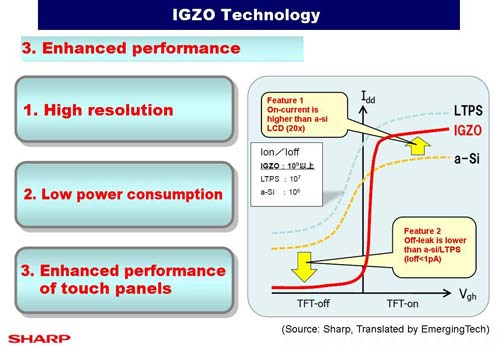
Source: semiconportal.com
In addition to this adaptive refresh rate, the TCON supports panel self-refresh which is hardly news, but given that we’ve seen phones and tablets in this year ship without panel self-refresh it’s worth mentioning.
The panel itself also appears to have dual domain pixels and a conventional RGB stripe. Viewing angles as a result are quite good. The cover glass also contains the AR coating first introduced with the iPad Air 2, which cuts reflectance roughly in half relative to a display that doesn’t have such a coating. This effectively doubles outdoor contrast, so it’s great for outdoor use.
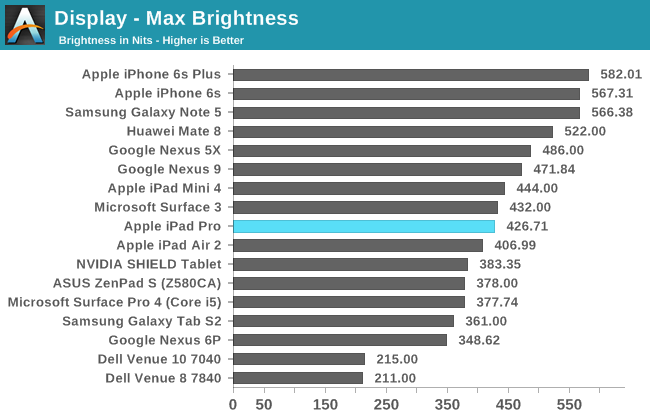
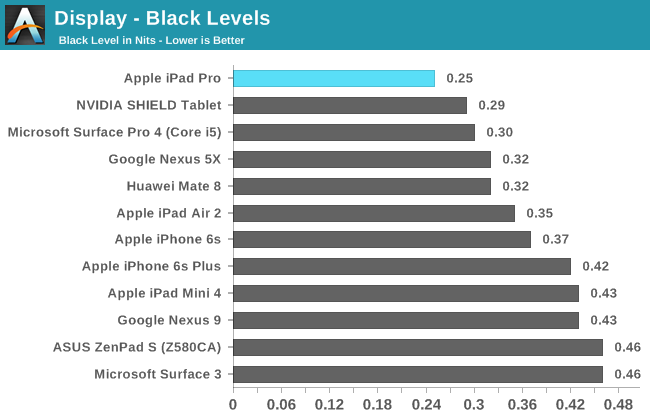
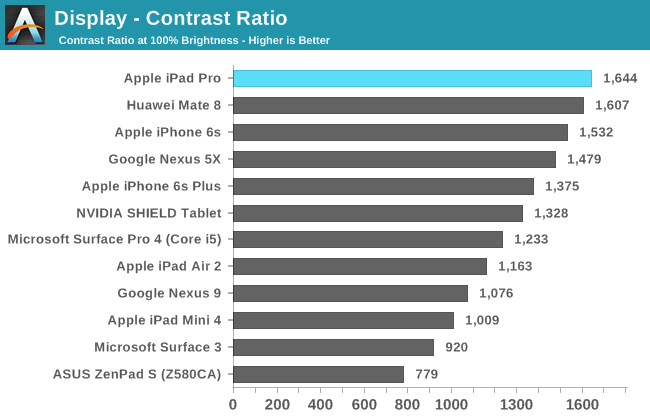
In our standard test of brightness and contrast, it’s evident that Apple has moved to a new generation of display for the iPad Pro as the maximum brightness is mildly improved relative to the iPad Air 2. The real change here though is that contrast is dramatically improved over the iPad Air 2.
This is likely due to the use of photoalignment for the liquid crystals, which helps the liquid crystal to have a more consistent orientation. For those that aren’t really familiar with the particulars of how light polarization and polarizers work, part of the problem is that when a voltage is applied to change the structure of the liquid crystals parts of the liquid crystals won’t necessarily change in structure appropriately. In order to assist with this process a film is applied which gains a particular orientation when exposed to UV light in a specific way. This helps to get the liquid crystals to all align in the same direction, which improves contrast as a result. Of course, contrast isn’t the dark, inky blacks that you'll get with AMOLED but it'll still be quite impressive for normal use.
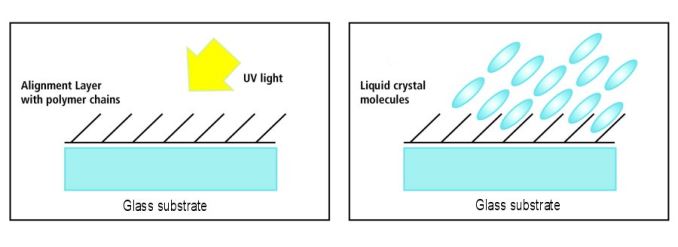 Source: eetimes.com
Source: eetimes.com
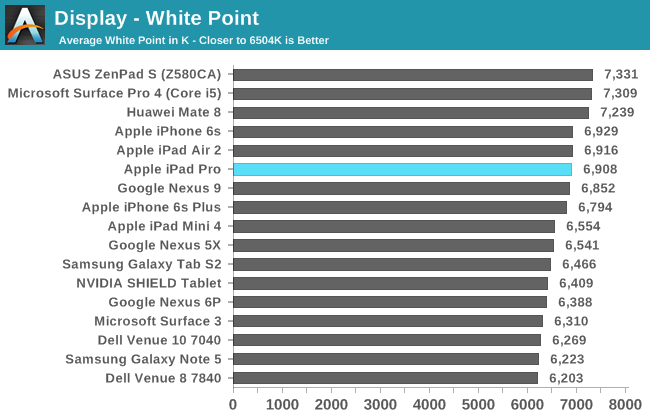
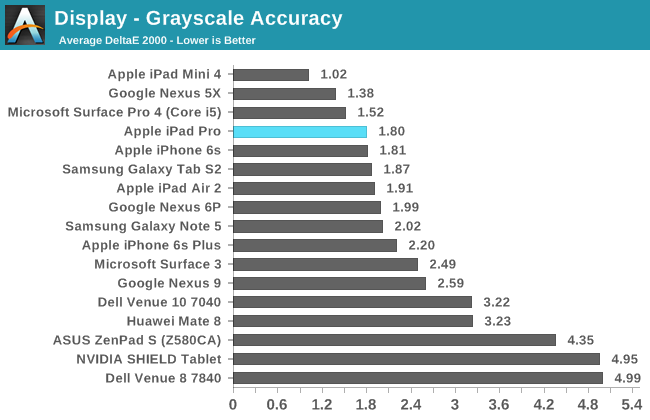
Moving on to our grayscale test, the iPad Pro does impressively well overall with well-controlled gamma but tending slightly towards a colder color balance. I’m not sure whether this is because of backlight efficiency concerns due to the use of blue LED with yellow phosphor in the backlight or because people seem to prefer colder white balances in general, but it’s there nonetheless. The cold color balance might affect some particularly color critical work but even for medical use I suspect it shouldn’t be a serious problem.
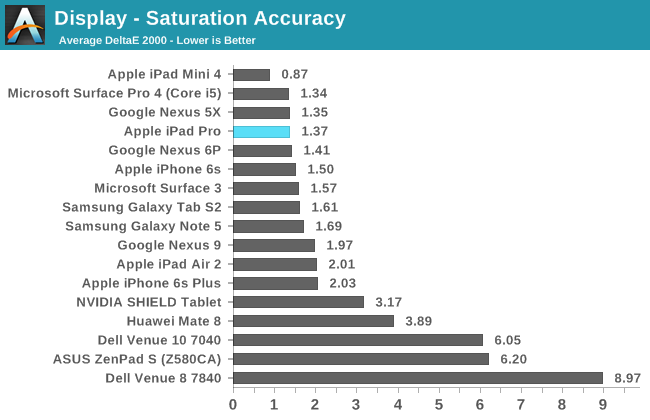
In saturations, the iPad Pro is basically perfect. There is some mild undersaturation of red, but I basically see no reason to try and find some method of personally calibrating the display.
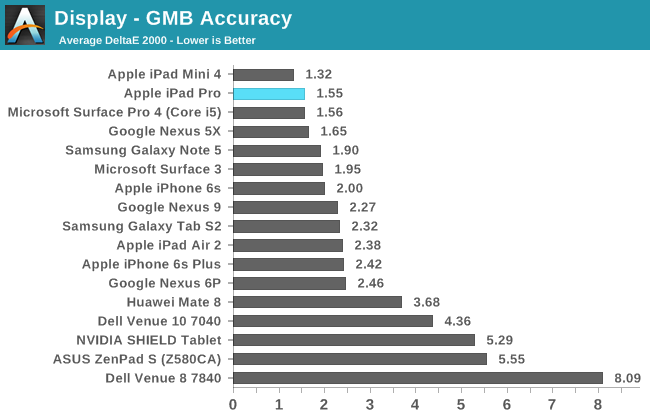
In the Gretag MacBeth ColorChecker test, color error is once again basically nonexistent. Anything with red appears to be mildly undersaturated but the error is going to be almost impossible to notice.
Overall, the iPad Pro display is probably one of the best available on the market today. The Galaxy Tab S2 display is comparable in overall accuracy and has superior contrast, but the iPad Pro has noticeably higher brightness for all content above 50% APL and in any scenario with a lot of ambient background light the AR coating will help a lot with improving effective contrast and general readability. Although pixel density is equivalent to the iPad Air 2, the sheer size of the display means that the viewing distance is increased and therefore the perceived resolution. The display looks great in person, and unless your single point of consideration for display performance is contrast I think it’ll be hard to be disappointed with the iPad Pro display.


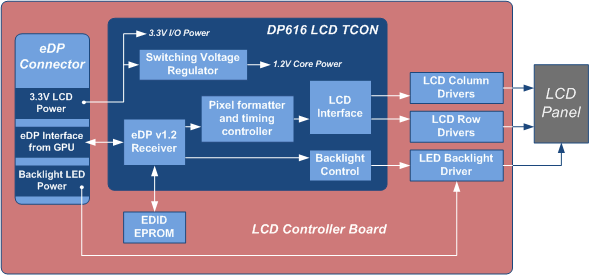
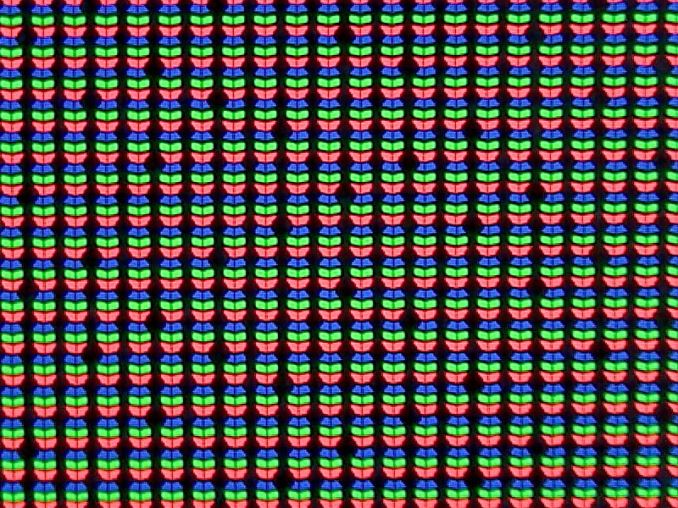

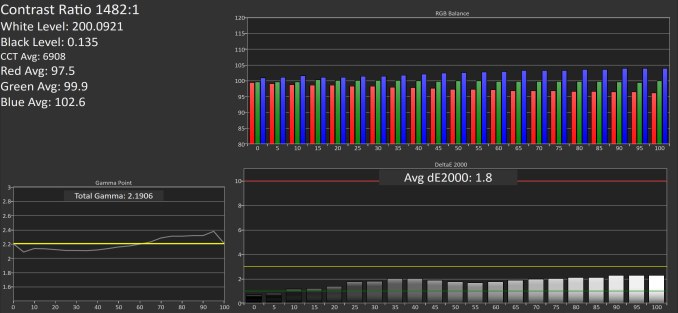
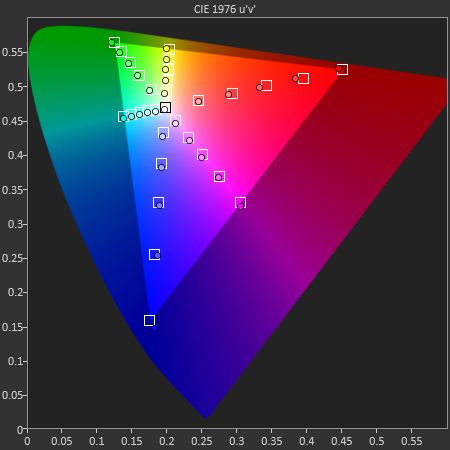
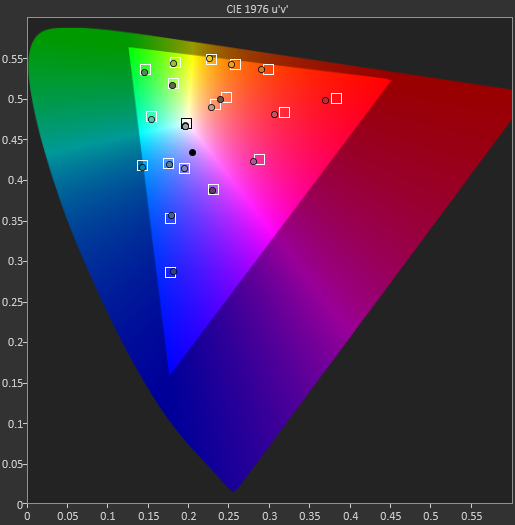








408 Comments
View All Comments
lilmoe - Friday, January 22, 2016 - link
ok......Sc0rp - Friday, January 22, 2016 - link
Well, I have to disagree with you on one thing here. I don't think Apple has any blame here when it comes to software. iOS9 is faaaaaaaar more powerful and capable than Mac OS 8 and 9 that I used to run on my power PC's back in the late 90's. Those computers were certainly productive. There's nothing on a software level that's really stopping developers from making productive software for the iPad Pro or even the Air. There is an interface challenge, much as there was an interface challenge when GUI's first came out. As I recall, people lambasted GUI's and mouses as being toys and not for serious work back then. The endless whining over the iPad Pro is just a reverberation of that. People don't like change and they don't like things that rub against their doctrine. But, consider this... While many adults actually have some difficulty adapting to this new computing paradigm, youngsters adapt to it like a fish to water.I think it is a wild boast to call an iPad Pro a 'useless toy'. I certainly have made a ton of use of mine. Of course, I'm an artist so there's that. Not to mention that my iPads have been my primary communication hub for the last five years.
Jumangi - Friday, January 22, 2016 - link
iOS blows as an actual productivity system. It is made for smartphones first(Apple's cash cow) and everything else second. Put a version of Mac OSX on this and you have something. Right now this is an expensive artists toy.strangis - Friday, January 22, 2016 - link
> While many adults actually have some difficulty adapting to this new computing paradigm, youngsters adapt to it like a fish to water.That's why I, as someone of the Commodore Vic 20 era, has to show relatives and clients 25 years younger than me how to use their phones, tablets and computers every week. Regardless of age, some people get it, some don't.
Similarly, I've never seen the value of an iPad Pro when, as an artist), I need to finish in Photoshop or After Effects. The creative tools available on the iPad Pro are limiting for those of us used to more, and considering its price, better to buy something that will get the job done.
Murloc - Saturday, January 23, 2016 - link
I have no doubt people will only use tablets once they'll be able to interact with the interface with their brains.Relic74 - Saturday, February 27, 2016 - link
Yea but at least Mac OS had a proper file-system, allowed it's users to select their own default apps, appsdidn't require API's in order to talk to the system, all applications used the same resolution, when a new feature was added to the system every app was able to utilize it immediately and didn't require it's developer to update their apps, the user was ablue to customize their desktop and even the UI, supported widgets, applications were windowed and ran desktop software. Actually, I take it back, Mac OS's UI was a lot more powerful, the system not so much, which is reversed in iOS, the UI isn't very powerful, it's actually pretty vanilla, though it's BSD underpinnings are extremely powerful. If I was able to access the BSD system, I would dump iOS's UI in a heart beat and install a X desktop environment like Gnome 3, which actually works fairly well as a tablet OS. Than maybe the iPad Pro would actually be a Pro device. I'm running Arch Linux on a Xiaomi MiPad 2, love it.NEDM64 - Friday, January 22, 2016 - link
Dude!If you were in the 80's, you'll be advocating text user interfaces instead of graphical user interfaces.
If you were in the 70's, you'll be advocating separate terminals connected to computers, as opposed to "all-in-ones" or "intelligent terminals" like the Apple II, Commodore PET, TRS-80.
Opinions like yours, with due respect, don't matter, because people like you, already have their rigs in place, and aren't in the market.
Apple's market position is for people that want the next thing, not the same ol' thing…
RafaelHerschel - Saturday, January 23, 2016 - link
Apparently the next thing is a larger iPad. I'm going to be bold and predict the next next thing. It's going to be a slightly thinner version of the larger iPad. Awesome.Murloc - Saturday, January 23, 2016 - link
you aren't understanding tilmoe's posts.You can spend millions developing software for a superpowerful tablet.
You will still never be able to fit Photoshop's whole interface and abundance of options and menus into the tablet in a way that the user is easily able to reach them, without scrolling through pages of big buttons.
At the end of the day, you'll get a crippled version of photoshop and the user will have to get on a traditional computer (a WORKstation, not because it's more powerful, not because software houses invest more in it, but because it has human interaction devices and a big screen that enable humans to get work done faster) to get stuff done.
Tablets are mostly content consumption products exactly because of the limited interfaces. They have the advantage of portability and ease of use, you just open apps while on the couch, and that's why they master content consumptions better than say laptops.
Constructor - Saturday, January 23, 2016 - link
It's by now become a quasi-religious belief system for some that "mobile devices cannot ever be used for any professional purposes whatsoever!".At the same time more and more people (and businesses!) don't care about such beliefs in the slightest and simple use those devices very much professionally and in many cases with more success and higher productivity than they'd had with conventional computers.
Part of the reason is that agility and flexibility often beats feature count, all the more so since professional workflows very often just can't afford to even consider most of the myriad theoretical options some desktop programs offer. Heck, most professional uses actually don't need much more than a browser interface anyway!
Yes, there are some uses for which desktop or mainframe computers will be the only really viable option. But what you and many others didn't seem to have noticed is that those domains have been shrinking rapidly over the last decade(s).